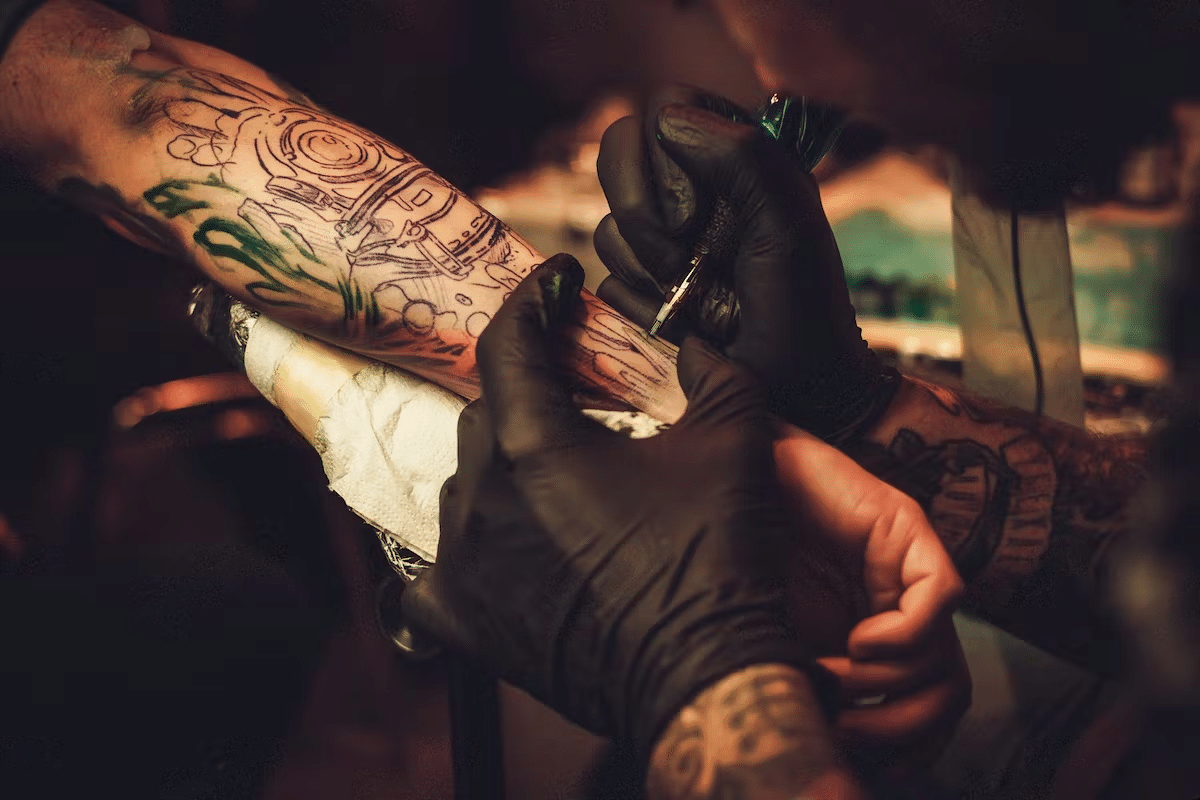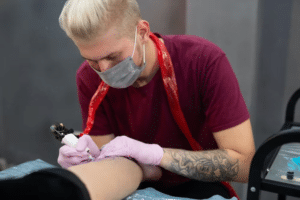Dive Right In : A Guide To Waterproof Tattoos In The Pool
Are you looking for ways to keep your new tattoo safe while swimming?
Waterproofing a tattoo is important to ensure it stays vibrant and beautiful. Swimming in the pool or ocean can be fun, but it can also harm your new ink if you don’t take the right steps. From choosing a waterproof tattoo barrier to applying the right aftercare, this article will provide all the information you need to know on how to waterproof a tattoo while swimming.
Swimming With A New Tattoo
If you’ve just gotten a new tattoo and love swimming, you may wonder if it’s safe to dip in the pool or ocean. While getting inked is an exciting experience, taking care of your fresh tattoo is important until it fully heals.
One of the biggest concerns for those with new tattoos is whether they can safely swim without damaging their artwork.
During this time, your skin will be healing, and any exposure to water – especially chlorinated water – can lead to infection and damage to your tattoo. Additionally, prolonged exposure to sunlight (while swimming outdoors) can cause fading and discolouration of your fresh ink.
Determining When To Swim After A Recent Ink Session
If you are a proud owner of a brand new tattoo, you may wonder when it will be safe to plunge into the pool or ocean. After all, nobody wants their fresh ink to get ruined or fade away due to water exposure. So, when can you go underwater with your new tattoo?
First, it is important to note that every person’s body and healing process differs. Generally speaking, it is recommended that you avoid submerging your tattoo in water for at least two weeks after getting inked. This allows enough time for the skin to heal and for the top layer of scabbing or peeling skin to come off naturally. Once those two weeks have passed, you may still want to exercise caution when exposing your tattoo to water.
One of the most important things to consider when deciding whether your tattoo is waterproof is its location on your body. Areas that are more prone to rubbing against clothing, such as your back or chest, will generally take longer to heal than less exposed areas. Additionally, tattoos on areas with higher blood flow tend to heal more quickly than those in areas with lower blood flow.
Protecting A New Tattoo When Swimming
Getting a new tattoo is an exciting experience, but it comes with a responsibility to take care of it properly. One of the biggest concerns for people recently getting a tattoo is protecting their new ink when swimming. It’s important to know that exposing your new tattoo to water before it has fully healed can result in fading or even infection.
Wrapping Your Tattoo In Plastic Wrap
If you’ve just gotten a new tattoo, your artist would recommend wrapping it in plastic wrap. This is because keeping the tattoo covered in plastic wrap can help prevent bacteria from entering the wound and causing infection. In addition, wrapping your tattoo in plastic can protect it from water damage while it’s still healing.
Before wrapping your tattoo in plastic, ensure the area is clean and dry. Use mild soap to wash the area and pat it dry with a clean towel. Once the area is clean and dry, apply a thin ointment or moisturiser layer to help soothe discomfort or itching.
When you’re ready to wrap your tattoo, use a high-quality waterproof plastic wrap that will stay securely in place without slipping or bunching up.
Sealing A Medical Sealant
Sealing your tattoo with a medical sealant is an excellent option for those who want to keep their tattoo waterproof. A medical sealant can be applied to the skin in a thin, transparent layer that covers the ink and protects it from water damage.
Sealing your tattoo with a medical sealant involves carefully cleaning the area around the tattoo and applying the sealant in a smooth, even layer. The sealant will dry quickly, leaving behind a clear, waterproof barrier that will protect your tattoo from water damage.
One of the benefits of using a medical sealant to protect your tattoo is that it is easy to apply and does not require any special tools or equipment. Additionally, because it forms a transparent barrier over your tattoo, you won’t have to worry about altering its appearance or compromising its integrity.
Tattoo Care After Swimming
After getting yourself tattooed with waterproof ink, staying away from swimming pools and beaches for at least two weeks is recommended. This might seem difficult for those who love the water, but keeping your body dry during this time can help the tattoo heal. When you do get back into the water, make sure that you rinse your tattoo well with fresh water once you’re out of the pool or sea.
Possible Risks If You Ignore This Guide
Getting a tattoo is a popular way to express oneself, but it’s important to understand the potential risks and health issues that come with it.
One of the biggest concerns for those with new tattoos is swimming. While it may seem harmless, swimming in pools or natural bodies of water can increase the risk of infection due to bacteria and other microorganisms present in the water. You should wait for at least 2-3 weeks before submerging your new tattoo in water and avoid swimming altogether if you have an open wound or scabbing.
Additionally, chlorine and other chemicals used in pools can cause irritation and damage to the skin surrounding the tattoo. Even then, taking precautions such as covering the tattoo with waterproof bandages or avoiding submerging it completely is important.
Conclusion
In conclusion, waterproofing your tattoo for swimming is a great way to ensure your new tattoo stays perfect. Following the steps outlined in this article will help you protect and waterproof your tattoos for all your adventures in the pool, lake or ocean. Always moisturise your skin before and after swimming to keep it healthy and hydrated. Additionally, take extra care when selecting a sunscreen that won’t irritate or damage the tattoo.
FAQs
Do waterproof tattoo inks exist yet?
Yes, waterproof tattoo inks do exist. These inks are designed to last longer than traditional inks and are resistant to fading when exposed to water or sweat. Waterproof tattoo inks are made with a special formula that includes ingredients such as glycerin, propylene glycol, and other compounds that help keep the ink from fading or running when exposed to water.
Does the ink change colours when you swim?
Generally speaking, no. The ink used in tattoos is designed to be permanent, so it should not change colour when exposed to water. However, some factors can affect the appearance of a tattoo after swimming.
One factor is the quality of the ink used. Low-grade inks may fade or change colour over time, especially when exposed to water regularly. Additionally, if the skin was not properly cared for after getting a tattoo, it could fade or change colour when exposed to water.
How long can tattoos stay in the water?
Generally, it is recommended that you keep your tattoo out of water for at least two weeks after getting it done. This will allow the ink to be properly set into the skin and ensure it doesn’t become distorted or discoloured. After these two weeks, you can submerge your tattoo in water for short periods; however, it’s best to avoid long exposure to water if possible. Prolonged soaking in hot tubs or swimming pools can cause fading and damage to the tattoo over time. Additionally, you should always apply a high-quality moisturiser after exposure to water, as this will help keep your tattoo looking its best.




